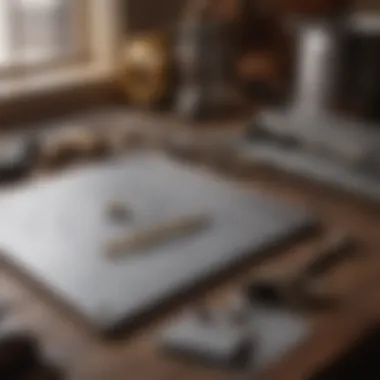Mastering Square Footage Calculation Techniques


Intro
Calculating square footage is not merely a mathematical exercise. It is an essential pre-requisite for various activities in life, including real estate transactions and interior design. A clear understanding of how to accurately measure and compute the square footage of a space can lead to better decision-making and well-informed choices. Recapturing this skill can be beneficial, especially when it comes to estimating property values or improving personal living spaces.
Whether you are a real estate enthusiast, travel lover, or interior design aficionado, knowing the methods and techniques to calculate square footage effectively is invaluable. This article aims to provide a comprehensive guide to facilitate your journey into understanding square footage, with in-depth insights on methodologies, tools, and common mistakes to avoid.
Exquisite Architectural Designs
The understanding of square footage significantly impacts architectural designs, influencing both aesthetics and functionality.
Unique Home Features
Historical Significance
Calculating square footage also plays a role in preserving historical homes and buildings. Each element—be it a quaint loft or an expansive estate—holds significance in understanding its market value and historical context. Knowing the square footage can elucidate not only the structural characteristics but also the cultural stories entwined within these spaces.
Interior Decorating Tips
To utilize square footage effectively, applying interior decorating principles can elevate the result substantially.
Color Schemes and Trends
Understanding how color schemes can affect perceived space is crucial. For instance, lighter colors may create an illusion of more space, impacting how square footage feels. Knowing the dimensions allows decorators to make informed choices about color applications in a room. An optimal color scheme can enhance the overall aesthetic while working in harmony with the square footage available.
Space Optimization Techniques
Maximizing the use of square footage is achievable with systematic space optimization techniques. This involves selecting furniture that fits the dimensions well and choosing designs that utilize vertical space effectively. By measuring accurately, homeowners can better assess furniture placement and layout choices, thus enhancing both functionality and design.
"Incorporating knowledge of square footage into interior design is not just about fitting items in; it is about creating a cohesive experience within a space."
Understanding square footage is critical. It serves as a foundation for various practical applications, aiding in everything from real estate assessments to enhanced living conditions through better design choices. This article will further delve into the actual calculation methods and practical techniques that can be leveraged to derive maximum benefit from understanding square footage.
Foreword to Square Footage
Calculating square footage is a foundational skill that touches many aspects of life, particularly in real estate and design. Whether you're buying a home, planning a renovation, or decorating a space, knowing the square footage can significantly influence your decision-making process. This section will examine why square footage matters and outline how understanding it can benefit various projects.
Defining Square Footage
Square footage is a measure of area that describes the size of a space. It is derived from calculating the area in square feet. For instance, if a room measures 10 feet by 12 feet, the square footage would be 120 square feet. This simple calculation allows homeowners, renters, and professionals in real estate to determine how much space they have available. Notably, it serves as a standard measurement across different sectors, bringing consistency to how space is assessed.
Importance of Square Footage in Various Contexts
The significance of square footage extends into various domains, each with unique implications:
- Real Estate: Buyers and sellers often assess property value based on square footage. Larger spaces typically command higher prices. Suffice it to say, knowing accurate measurements is crucial in negotiations.
- Interior Design: Designers need square footage to create functional and aesthetically pleasing layouts. Understanding how much space is available helps in choosing the right furniture, colors, and materials.
- Home Renovations: A renovation project relies heavily on accurate square footage calculations. This measure informs everything from budgeting to material selection.
"When you know the square footage, you hold the key to maximizing the potential of any space."
Clearly, square footage is not merely a number; it is a metric that can influence choices and outcomes in various contexts. Knowing how to calculate it accurately can lead to more informed decisions and ultimately better results.
Basic Principles of Measurement
Understanding the basic principles of measurement is critical when calculating square footage. Accurate measurements underpin all further calculations and ensure that the space is correctly quantified. This accuracy influences decisions in various fields, including real estate, architecture, and interior design. Miscalculating square footage can lead to lost value or misjudged space requirements in projects.
Three primary elements encapsulate the measurement process: units, tools, and methodology. Each of these aspects plays a vital role in ensuring precision and consistency in the calculations.


Understanding Measurement Units
Measurement units are the foundation of the calculation process. Square footage involves two-dimensional measurements expressed in square units. The most commonly used units include square feet and square meters. It is essential to be consistent in the unit of measurement throughout the calculation to avoid discrepancies.
- Square Feet: This unit is primarily used in the United States. Professionals measure the length and width of a space in feet and then multiply these dimensions to achieve the square footage.
- Square Meters: This unit is often used in many parts of the world, including Europe. The measurement process remains similar but uses metric dimensions.
Both units can be converted into one another, but care must be taken to maintain accuracy during these conversions. A calculator can simplify this process.
Tools for Measuring Square Footage
The right tools can significantly improve accuracy when measuring spaces for square footage calculations. The following are some effective tools:
- Measuring Tape: A classic tool used for taking direct measurements of length and width. It is flexible and easy to store.
- Laser Distance Measurer: This device offers precision and efficiency. It can quickly measure distance, making it ideal for larger areas.
- Area Calculator Apps: These applications utilize the dimensions inputted by the user to compute square footage on smartphones or tablets.
Each tool has benefits and limitations. For instance, while laser distance measurers can provide quick results, they may not be as accessible or cost-effective as a traditional measuring tape.
Calculating Square Footage of Regular Shapes
Calculating square footage for regular shapes is a foundational skill in many domains, such as real estate, construction, and interior design. Understanding how to measure these common geometric forms allows individuals to make informed decisions regarding space utilization, property assessment, and aesthetics. With precise calculations, one can evaluate the worth of a space, plan renovations, or even maintain safety standards in various contexts. This section discusses the measurement of rectangles, squares, circles, and other prevalent shapes, emphasizing the critical steps to ensure accuracy in square footage calculations.
Calculating the Area of Rectangles and Squares
Rectangles and squares are among the simplest shapes to measure. The formula for calculating area focuses on multiplying length by width. For squares, where all sides are equal, the formula simplifies to side squared.
To illustrate:
- For a Rectangle: Area = Length × Width
- For a Square: Area = Side × Side
Consider a rectangle that is 10 feet long and 5 feet wide. The calculation would be as follows:
- Area = 10 ft × 5 ft = 50 square feet.
For a square measuring 4 feet on each side, the area would be:
- Area = 4 ft × 4 ft = 16 square feet.
Being meticulous in these calculations is crucial to avoid common mistakes. Double-checking measurements and ensuring they are in the same unit is vital. The implications of miscalculating can range from minor inconveniences in design to significant financial discrepancies during real estate transactions.
Calculating the Area of Circles
Circles present a different challenge but are equally necessary to quantify. To find the area of a circle, one must know its radius, which is the distance from the center to the perimeter. The formula for calculating the area is:
- Area = π × Radius²
If a circle has a radius of 3 feet, the area is calculated as follows:
- Area = π × (3 ft)²
- Area ≈ 3.14 × 9 ft²
- Area ≈ 28.26 square feet.
Understanding how to measure circular areas can be particularly useful in fields like landscaping or architecture. Each precise calculation builds confidence while planning spaces or evaluating properties.
Square Footage of Other Common Shapes
Beyond rectangles, squares, and circles, many other shapes are important in square footage calculations, including triangles, trapezoids, and polygons. For various shapes, specific formulas apply:
- Triangle: Area = 1/2 × Base × Height
- Trapezoid: Area = 1/2 × (Base1 + Base2) × Height
- Polygon: Area = (Perimeter × Apothem) / 2


Calculating the area of more complex shapes often requires breaking them down into smaller, regular shapes. For example, a triangular area can be dissected from a rectangular space, allowing for easier calculations.
Calculating Square Footage of Irregular Shapes
Breaking Down Irregular Shapes
To calculate the square footage of an irregular shape, one must first break down the area into smaller, manageable components. This involves visualizing the entire shape and identifying various sections that can be treated as standard shapes such as rectangles, triangles, or circles. For instance, a T-shaped area can be split into a rectangle and two additional rectangles.
Steps to break down an irregular shape include:
- Sketch the shape: Draw a rough outline of the irregular area, noting its dimensions. Use grid paper for more precision.
- Identify recognizable shapes: Look for sections that resemble rectangles or triangles in the outline. Mark them clearly.
- Calculate each section's area: Use standard formulas for calculating area. For rectangles, multiply the length by the width. For triangles, use the formula: Area = (base x height) / 2.
- Add the areas together: Sum all the areas of the identified shapes to determine the total square footage of the irregular area.
For example, irregular lots in real estate often require breaking down the land’s boundaries. Estimating the square footage accurately is essential for pricing and effective marketing strategies, thus benefiting potential buyers.
Using Grid Method for Calculations
The grid method offers a practical approach to approximating the square footage of irregular shapes by overlaying a grid of known dimensions, such as one-foot squares, on the irregular area. This technique is particularly useful when precision tools are lacking, or the shape has complex curves or angles. Here is how it works:
- Overlay a grid: Place a grid on top of your drawing of the irregular shape. Ensure that each grid square represents a fixed area, such as one square foot.
- Count the full squares: Determine how many complete squares fall within the irregular shape. Each counted square will represent a specific amount of area, depending on your chosen grid.
- Estimate partial squares: For squares that are only partially covered, those can be estimated. Usually, if more than half of a square is included, count it as full. If less, count it as none.
- Calculate total area: Add the number of full squares and the estimated partial squares to obtain an approximate area for the irregular shape.
This method also offers an intuitive understanding of space that can assist in real estate or renovation planning. Approximations might not always be perfectly accurate, but they provide a satisfactory basis for making effective decisions.
Advanced Measurement Techniques
In the realm of square footage calculations, advanced measurement techniques encompass a range of methods that enhance precision and efficiency. These techniques become especially vital in scenarios involving differing elevations and multi-level spaces or when harnessing technology to improve measurement accuracy. Mastering these techniques increases the confidence of individuals tasked with measuring properties, ensuring that their calculations align closely with reality. They offer valuable insights, allowing for better planning in real estate, design, and renovation projects.
Incorporating Elevation and Multi-level Spaces
When opting to measure spaces with elevation or multiple levels, it is crucial to understand how such factors can impact square footage calculations. Conventional flat measurements generally suffice in basic scenarios, such as a single-story room. However, structures that possess varied heights, like split-level homes or buildings with basements, necessitate a more nuanced approach.
To accurately assess square footage in these cases:
- Measure floor area at each level: For multi-level buildings, calculate the area of each level separately. Each space must be added to derive total square footage.
- Consider ceiling height: When dealing with areas like lofts or open spaces that feature high ceilings, properly evaluate how to account for this volume. Some dimensions might influence design and usability.
- Use elevation tools: Surveying equipment such as laser distance meters or theodolites can offer precise readings. These are particularly beneficial when measuring heights and slopes.
Remember that proper documentation of each floor's measurements is vital. Keep a clear record as you move from level to level, which will streamline the overall calculation process.
Utilizing Technology in Measurements
Modern tools and technological advancements have transformed how square footage is measured. There are several tools available that improve accuracy and save significant time in the measurement process.
- Digital Measuring Tools: Devices like laser measurement tools allow for quick and accurate calculations of distances, eliminating the guesswork often associated with traditional tape measurements. These laser tools can measure distances from several hundred feet away with ease.
- 3D Scanning Technology: More complex spaces may benefit from 3D scanning devices that create a detailed model of a property. This visual representation can assist in understanding intricate layouts, making calculations easier.
- Mobile Applications: Numerous mobile applications are now available that can assist in calculating square footage. They often use the phone's camera to help measure distances. Ensure the app you choose integrates reliable measurement algorithms.
Employing technology not only adds a layer of precision but also enhances the overall efficiency of the measurement process. Analytical capabilities can lead to better planning and resource allocation, particularly in professional settings where errors can result in significant cost implications.
Advanced measurement techniques can transform the way square footage is calculated, ensuring that accuracy remains paramount in any project.
Common Errors and How to Avoid Them
Understanding common errors in square footage calculations is essential for anyone involved in real estate, interior design, or home improvement. These mistakes can lead to inaccuracies that affect property values, design choices, and financial decisions. Having a clear grasp of these errors and knowing how to prevent them ensures reliability in measurements. Here, we will explore specific errors and strategies to avoid them, promoting accuracy and efficiency in your calculations.
Mistakes in Measurement Techniques
One of the predominant pitfalls in measuring square footage is the improper use of measurement tools. Relying solely on measurement tapes may lead to errors due to human oversight or a lack of proper technique. For instance, measurements taken at awkward angles or with the tape not held taut can yield incorrect results. Furthermore, using units interchangeably can also create confusion. For example, mixing feet with inches can dramatically alter the final square footage value.
To counter these pitfalls, one should always double-check measurements. This means measuring twice and ensuring that each room's dimensions are consistently calculated. Here are some practical tips to enhance accuracy:


- Use a reliable tape measure or a laser distance measurer for precision.
- Ensure measurements are taken from one fixed point to another, maintaining proper angles.
- Keep a notepad to document measurements as you go.
By implementing these steps, measurement errors can be significantly reduced.
Understanding Variable Measurements
Variable measurements often occur in spaces where different surface levels exist, such as multi-level homes. A misunderstanding here can lead to significant discrepancies in square footage calculations. For instance, in a split-level property, the area may fluctuate based on where measurements are taken. Additionally, features like alcoves or bay windows can complicate the calculation, resulting in underestimating or overestimating usable space.
To mitigate confusion and ensure a thorough approach:
- Develop a systematic method for measuring variable spaces, such as always starting measurements from the same reference point.
- Make note of any architectural features that might impact square footage. Documenting them will simplify adjustments later on.
- Whenever possible, consult with professional appraisers or architects to verify complicated measurements.
Understanding how to address variable measurements is crucial. This awareness not only enhances accuracy but also supports informed decision-making in various applications, from buying real estate to planning renovations.
Practical Applications of Square Footage Calculations
Understanding the practical applications of square footage calculations is essential for numerous fields including real estate, design, and home renovation. Accurate measurements not only provide clarity but also enhance decision-making in various contexts. In this section, we will explore how square footage influences different industries and practical scenarios.
Real Estate Considerations
In the realm of real estate, square footage is a key metric. It plays a vital role in property valuation and is one of the primary factors buyers consider when purchasing a home. Properties are often listed with square footage prominently displayed. For instance, a larger square footage generally correlates with a higher price tag.
Potential buyers assess their needs against available properties, making square footage calculations critical. An apartment of 1,000 square feet may be sufficient for a single individual, while a family may require closer to 2,000 square feet. Investors also analyze square footage when evaluating rental properties. The rent charged often corresponds to the size of the unit, making accurate calculations imperative.
"In real estate, the dimension of a property can significantly impact its marketability and value."
Interior Design Implications
Interior designers rely heavily on square footage to create functional and aesthetically pleasing spaces. Knowing the square footage of a room allows designers to plan effectively. They consider how furniture, decor, and layouts will fit within the given dimensions. For example, a small living room may necessitate different design strategies compared to a large open space.
By calculating square footage accurately, designers can avoid overcrowding and ensure that the space feels comfortable. Additionally, this information assists them in sourcing materials, as some items are sold by the square foot. If a client wants to tile a kitchen floor, knowing the square footage is essential for estimating costs and ordering the correct amount of tiles.
Home Renovation Projects
Homeowners engaging in renovation projects must consider square footage for multiple reasons. First, it influences budgeting. If a homeowner wants to remodel their kitchen, knowing the square footage allows them to estimate costs for materials and labor accurately.
Secondly, square footage guides decisions on what can realistically be accomplished within the space. For example, if a homeowner wants to expand a kitchen, they will need to understand the existing square footage and how much additional space they can feasibly add. This knowledge is crucial for compliance with local building regulations as well. Many municipalities have specific codes regarding minimum square footage, particularly for living spaces.
Culmination and Future Considerations
In understanding how to accurately calculate square footage, the significance of wrapping up this journey cannot be overstated. This section not only solidifies the knowledge gained from previous sections but also sets the stage for practical applications in various domains such as real estate and interior design. Recognizing the methodologies and tools discussed helps to elevate one’s confidence in measuring spaces correctly.
The benefits of mastering square footage calculations extend far beyond mere numbers; they play a crucial role in property valuation and planning. A precise calculation can influence critical decisions in buying, selling, or renovating spaces. Moreover, awareness of common pitfalls and advanced techniques ensures that individuals make informed choices moving forward.
Future considerations focus on adapting to new technological advancements. As measurement tools evolve, staying updated on the latest methods will enhance accuracy and efficiency. Thus, embracing a mindset of continuous improvement in this area is essential for professionals and enthusiasts alike. Keeping abreast of trends and advancements in measurement technology opens up new opportunities for innovative design and real estate strategies.
"The ability to measure spaces correctly is foundational to effective design and real estate success."
Summarizing Key Takeaways
To conclude, several key points stand out regarding square footage calculations:
- Understanding Measurement Units: Knowledge of various units is vital for clarity in calculations and comparisons.
- Correct Techniques: Utilizing the appropriate tools and techniques ensures accuracy in measurements of both regular and irregular shapes.
- Applications in Real Life: Practical uses in real estate and design make this skill not only valuable but necessary.
- Avoiding Mistakes: Being aware of common errors can significantly impact calculation outcomes, promoting better results.
This summation of significant elements empowers readers to apply and refine their square footage calculation skills confidently.
Encouraging Continuous Learning in Measurement
The field of measurement is not static; it evolves based on new technologies and methodologies. Encouraging continuous learning in this area involves:
- Seeking Knowledge: Engaging in workshops, online courses, and literature focused on measurement practices can improve skills.
- Experimenting with Technology: Utilizing tools like laser measurers or apps can enhance accuracy and speed in measuring spaces.
- Networking with Professionals: Joining forums and discussions, such as those found on platforms like Reddit or Facebook, allows for knowledge exchange and growth.
- Staying Curious: A mindset of curiosity will lead individuals to explore innovative measurement solutions, integrating evolving practices into their skill set.















